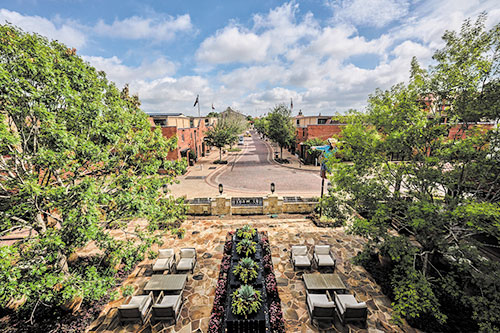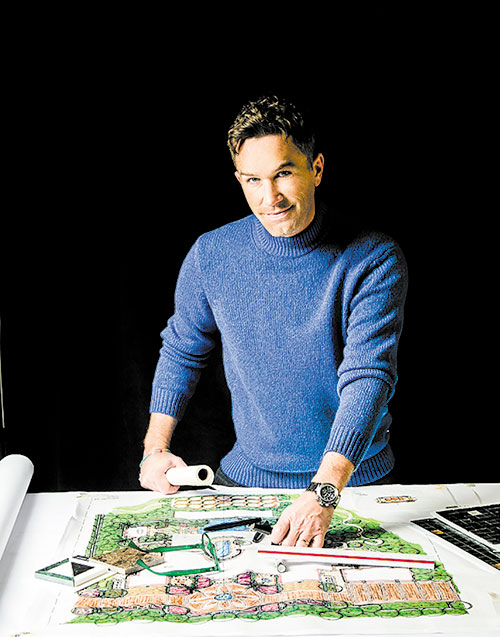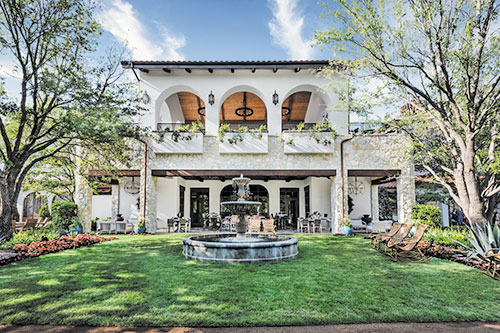Landscape architect aims to bridge the gap between classical and contemporary
TAMMYE NASH | Managing Editor
nash@dallasvoice.com
In his two decades as a landscape architect, Adam Kober has worked on many different internationally-recognized resort projects, including Hotel Drover and Mule Alley in the Fort Worth Stockyards. And last year, after 16 years as principal and lead designer with well-known Lifescapes International, he launched his own company, Kober Design Group.
This week, Kober talked with Dallas Voice about his career, his company and his ties to North Texas.
Dallas Voice: Tell me a little bit about your background — where you grew up, where you went to school. Tell me about your family. Do you have a spouse or partner? Adam Kober: I grew up on a large farm in Indiana where we raised corn and soy beans. After high school I went to Purdue University, where I studied landscape architecture and eventually took an internship out in Orange County, Calif. During that internship I fell in love with the West Coast, and so that’s where my husband and I now live with our two children.
I read on your website that Kober Design Group is based in Newport Beach, and that is where you live. But what ties do you have to Texas, especially North Texas? During my childhood we showed horses, and my love of horses has continued throughout my life as I now show and breed American Quarter Horses. Because some of the top trainers are in Pilot Point, Texas, I have been keeping horses at facilities in that area for over a decade now. Additionally, I’ve shown my horses multiple times at the Will Rogers Memorial Center in Fort Worth.

Adam Kober’s design in Mule Alley combines traditional with modern
What drew you to a career in landscape design? What advice do you have for someone who was interested in that field? I was always artistic as a kid, so I wanted to find a way to channel that creativity in order to make a living. Additionally, growing up on a farm helped create a love for the outdoors. So, when I heard that Purdue had one of the best landscape architecture programs in the country, it all seemed to fall into place. Landscape architecture is incredibly diverse in that there are many different areas in which one can choose to focus their career. For example, I love designing resorts and super high-end residential projects. However, some landscape architects prefer to design hiking trails for large parks. Both are very different paths, but both are under the umbrella of landscape architecture. My advice is to pursue the path that you’re naturally drawn toward.
So you spent 16 years with Lifescapes International as a principal and lead designer and just started your own firm last year. What prompted you to make that change? What are some of the advantages of running your own company compared to working for someone else? And what was the scariest part of striking out on your own? I love Lifescapes and am incredibly grateful for my time there. Making the decision to leave the safety of a well-known firm where I received a steady paycheck was incredibly hard and one of the most stressful things that I’ve been through. However, I was beginning to get restless, and I had started to yearn for a new challenge which included being more in control of the direction I wanted to take in my career.
 Fortunately, an opportunity came my way that afforded me the courage to make the leap. While I’ve worked more in the last nine months than I ever have in the past, the benefits and continued growth have been incredibly rewarding. And, luckily, being so busy has helped keep my mind from getting tangled up in the anxiety of being out on my own.
Fortunately, an opportunity came my way that afforded me the courage to make the leap. While I’ve worked more in the last nine months than I ever have in the past, the benefits and continued growth have been incredibly rewarding. And, luckily, being so busy has helped keep my mind from getting tangled up in the anxiety of being out on my own.
Tell me about your style, your aesthetic. Do you change your style at all to fit a project, or do you tend to choose projects that fit your style? What made you want to design for Hotel Drover and Mule Alley in the Fort Worth Stockyards? And what has been your favorite of all the projects you have worked on? I always tell people that my personal style is East Coast on the West Coast. I love old classic architecture with more traditional bones but that has a more contemporary twist in the way it’s decorated or finished. I think my personal aesthetic allows me to bridge the gap between traditional and contemporary fairly well, and makes me more diverse in my design abilities and appealing to a broader range of clientele.
 Hotel Drover is a great example of my style. While the Fort Worth Stockyards setting is incredibly traditional with a rich history, Hotel Drover and Mule Alley use a traditional foundation and infuse contemporary components to make it more relevant to the customers of today. For example, there is a 500-year-old solid limestone water trough that we found in a meadow in Belgium that we turned into a water feature, but there is also a brand new, contemporary metal water feature that I designed in the front of the hotel. There is a blending of both styles at Hotel Drover, and, somehow, it seems to work.
Hotel Drover is a great example of my style. While the Fort Worth Stockyards setting is incredibly traditional with a rich history, Hotel Drover and Mule Alley use a traditional foundation and infuse contemporary components to make it more relevant to the customers of today. For example, there is a 500-year-old solid limestone water trough that we found in a meadow in Belgium that we turned into a water feature, but there is also a brand new, contemporary metal water feature that I designed in the front of the hotel. There is a blending of both styles at Hotel Drover, and, somehow, it seems to work.
I don’t know if I have a favorite project. I’m invested in all of my projects and want them all to be successful. Of course, there are projects where I stop myself for a second to make sure I’ve taken in and appreciated the opportunity to work on such high-profile and historic properties, like Rockefeller Center in New York and the historic Fort Worth Stockyards.
Find out more about Adam Kober and his work, visit KoberDesignGroup.com. For more on Hotel Drover, located at 200 Mule Alley in Fort Worth, visit HotelDrover.com.













